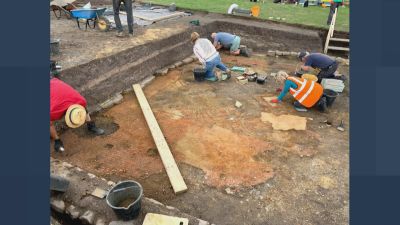Remains of a Roman mosaic floor re-exposed on Folkestone's East Cliff

The remains of a Roman mosaic floor covered-over some 65 years ago has been re-exposed on Folkestone's East Cliff.
The mosaic belongs to a large Roman villa built during the second century AD, which had more than 50 rooms.
Much of the villa site was excavated and laid out as a tourist attraction during the 1920s but the cost of upkeep led to the remains being reburied by Folkestone Council in 1957.
Experts say that the site is in danger of slowly falling into the sea over the course of the next 100 years.
Lead site archaeologist Keith Parfitt said: "The villa at Folkestone represents a very important site in the archaeology of southern Britain.
"Underneath the Roman villa traces of earlier buildings relating to the late Iron Age have been discovered - the villa had been placed on a site occupied by native Britons for centuries before the Roman invasion."
Mr Parfitt believes that in many ways the pre-Roman remains are of even more importance than the villa and they were largely missed by the excavators of the 1920s.
The mosaic will be reburied again at the end of the month pending discussions on whether it should be lifted and moved to a museum for permanent preservation and display.